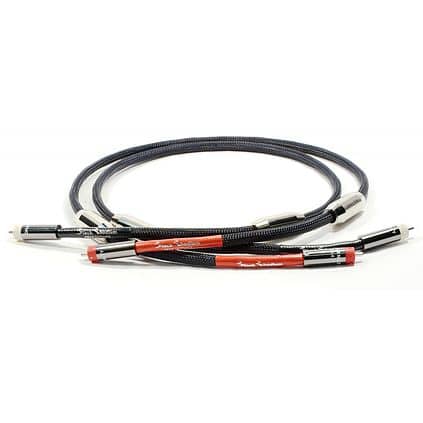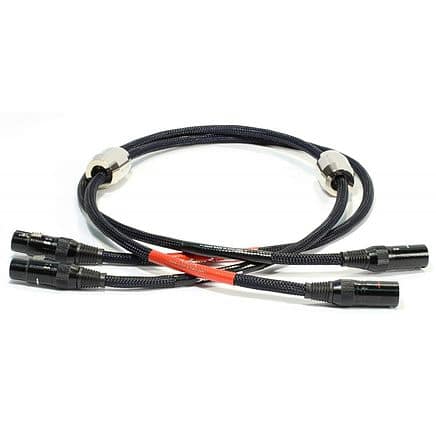The Article
Black Rhodium Aria DCT++ CS interconnect: Keep The Noise Down!
2nd November 2015

Black Rhodium has released a new, high-end, interconnect. Paul Rigby reviews the Aria DCT++ CS
Respected cable outfit, UK-based Black Rhodium has been busy developing a new suite of cables. One of those is a new Aria model. The company has experienced a recent issue in terms of length requirements. Some users have been asking for longer cables but the company’s hand-made approach has produced problems on that score so Black Rhodium out-sourced the manufacturing to enable the cable to be supplied on a reel.
Graham Nalty, the company’s founder, told me more about the construction of the Aria, “We started with a high grade silver-plated copper conductor. We found that this option had a clearer sound than copper. We avoided silver due of cost because we were buying in very large quantities. We also looked at PTFE insulation but decided upon a much thicker insulation option. The insulation for the Aria is 1mm thick. It is stiff but it does reduce noise. We found that this option was successful in the earlier Samba and Twist cables, in the past. It would also be ideal for a later digital version.”
Nalty next looked at potential microphony problems, so he specified a conductive layer between the insulation and the screen, a sort of tape impregnated with carbon, “We also wanted to reverse the negative and positive conductors to further reduce noise. A silver-plated copper screen was added to reduce RFI. A black, expandable polyester braid went over the top of the whole thing.”
Once constructed, the Aria plus rhodium-plated connectors was sent for Cryogenic Processing. This is where the cable is put in a low temperature bath and slowly, over the course of a day, reduced in temperature to -190 degrees, the same temperature as liquid nitrogen. The cables are left there at that temperature for another day and then the temperature is slowly lifted again.
“Finally, we also added vibration stabilisers, weighing in at 85g each. We originally intended to have a larger, heavier stabiliser but it was too impractical. We put one at each end of the cable. It is rigidly coupled to the cable to damp out vibrations. We have to compromise with weight, otherwise we would have a stabiliser along the entire length of the cable! The tests I’ve done indicate that one stabiliser has almost enough effect to give you the benefits. We decided to provide two, though, to remove any chance of compromise.”
One final thing, for the the connector, there is a line contact between the earth return and the earth side of the connector in a straight line rather than around the circumference, “This tweak improves sound quality. This is all to do with eddy currents and time delay issues in the signal going around different parts between the plug and the socket.”
I hooked them up for some serious listening.
SOUND QUALITY
I chose the instrumental prog track, Los Endos, from Genesis which is complex and varies the tempo on frequent occasions while providing a range of instrumental frequencies to give the cables a good work out.
The pastoral synth introduction provided a precise presentation with an upper midrange that pushed towards strident without getting there. Never bright, the upper mids, nevertheless, pushed the forward nature of the frequencies to the limit, which gave the delicate details as much chance to shine as possible.
Also, during the complex percussive sequences on this track, it was easy to hear the cymbal work and secondary percussion. This polishing of the upper mids also gave the bass guitar extra illumination that allowed it to show its character to the full.
As such, the lower frequencies were influenced by the lifting of the mids, giving the drums a precision and speed that kept the percussion moving at a fair pelt without any smearing or blooming. The accuracy of the drums, in fact, added to the bass punch and impact that gave this track force and power.
Moving to spoken word and Michael Parkinson’s BBC interview with the comedy actor, Peter Sellers during the early 70s, on BBC-produced vinyl. The LP side began with a quick live song, in front of a live audience. Sellers’ voice was full of texture with an emotive delivery. The quiet relatively clinical nature of the upper mids demanded that I lower the volume a tad but, once the conversation continued, the exchange of Parkinson’s and Sellers’ voices was both expansive and detailed in their projection. Whereas the Ultra Black Tellurium Q cables, used as reference, were precise and lean and trim, the Aria’s were also precise but not quite as trim. The relative lack of focus from the Arias meant that the voices were artificially fuller in their nature but this factor did fill the soundstage and gave the presentation an epic feel to the recording, as if the conversation was more of a staged performance.
Spinning David Bowie’s album, Low, a recording with a warm production, was an ideal match for the Arias. The rather cool nature of the Arias balanced the Bowie LP and both got along famously as the Arias added a necessary edge to the upper mids that provided a welcome edge to the proceedings. The track, What In The World, featured an excellent guitar stream from Carlos Alomar plus synth noises from Brian Eno that never bled over each other. Each can be heard within the broad soundstage as individual instruments. On the hit single, Sound And Vision, George Murray’s famous bass line was distinct and characterful and tonally accurate while the harmonic vocal interludes were obviously a combination of individual voices and not, as can often happen with lesser cables, an amalgam or blob of noise. The Aria performed particularly well on this album.
CONCLUSION
The Black Rhodium Aria provided a forceful and strong sound that placed an emphasis on the upper midrange that shined a light on those frequencies. This sonic character might be too strident for some listeners. The cables also emphasised and etched the bass to add form and character to those lower frequencies. If your system is noticeably sharp and verging on the bright then the Arias might not be for you but other systems that need a slight edge will welcome the Aria’s bold presentation.
BLACK RHODIUM ARIA DCT++ CS
Price: £1,000 per metre
Website : www.blackrhodium.co.uk
Tel: 01332 342233
GOOD: precision, lively midrange, timing
BAD: slightly forward mids
RATING: 6
REFERENCE SYSTEM
Avid Acutus/SME IV/Benz Glider
Icon PS3 Phono amplifier
Aesthetix Calypso pre-amp
Icon Audio MB845 Mk.II monoblocks
Quad ESL-57 speakers with One Thing upgrade
Atlas Mavros speaker cables
Atlas Mavros innterconnects



